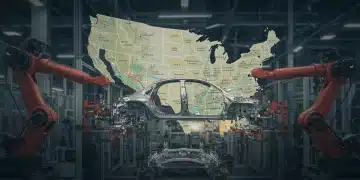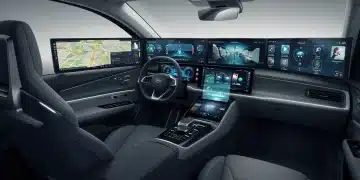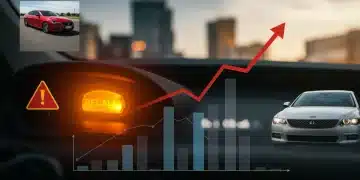Cybersecurity for Connected Vehicles: Protecting US Automotive Data in 2025 and Beyond
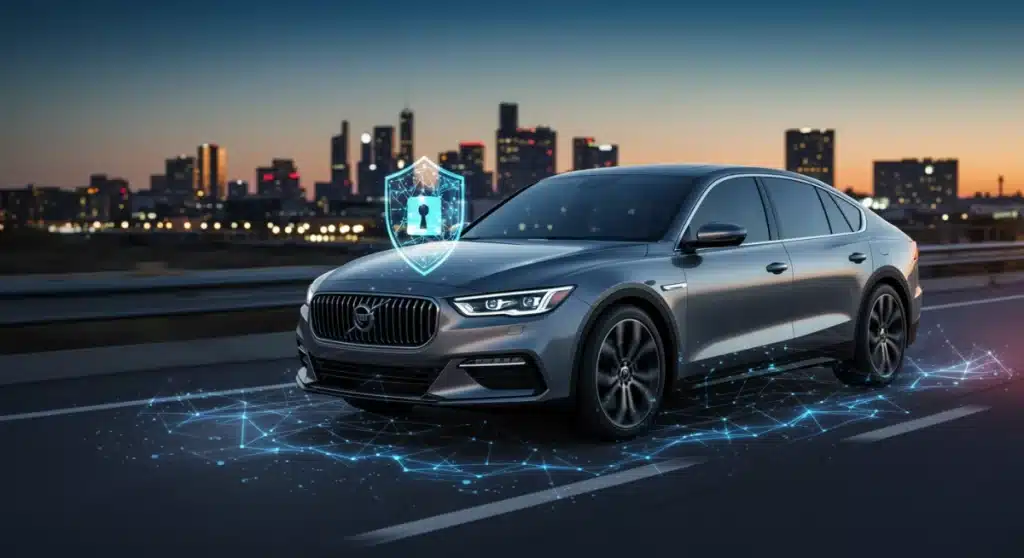
Securing US automotive data in connected vehicles by 2025 and beyond is a critical and evolving challenge requiring robust cybersecurity frameworks, proactive threat intelligence, and collaborative industry-government efforts to safeguard privacy and ensure operational safety.
Cybersecurity for Connected Vehicles: Protecting US Automotive Data in 2025 and Beyond is an urgent concern as our cars become increasingly integrated with digital networks. The rapid evolution of automotive technology brings unprecedented convenience but also introduces significant vulnerabilities that demand immediate and ongoing attention from manufacturers, regulators, and consumers alike.
The Evolving Threat Landscape for Connected Vehicles
The rise of connected vehicles has dramatically expanded the attack surface for cyber threats. As cars transform into mobile data centers, equipped with countless sensors and communication modules, the potential for malicious actors to exploit vulnerabilities grows exponentially. This evolving threat landscape necessitates constant vigilance and adaptation by the automotive industry.
Recent reports indicate a significant increase in cyberattacks targeting automotive systems, ranging from remote vehicle manipulation to data breaches. These incidents highlight the urgent need for enhanced security protocols and rapid response capabilities to protect both vehicle functionality and sensitive user data.
Key Vulnerabilities in Automotive Systems
Several areas within connected vehicle architecture present prime targets for cyber exploitation. Understanding these vulnerabilities is the first step toward developing effective countermeasures and fortifying defenses against potential attacks.
- Infotainment Systems: Often connected to external networks, these systems can be entry points for malware or unauthorized access to other vehicle domains.
- Telematics Units: Responsible for communication with external services, telematics units are critical for features like emergency calls and navigation but can also be compromised.
- Engine Control Units (ECUs): These vital components manage core vehicle functions, and a successful attack could lead to dangerous operational failures or even vehicle immobilization.
- Sensor Data Integrity: Autonomous driving relies heavily on sensor data; manipulation of this data could lead to misinterpretations and accidents.
The interconnectedness of these systems means a vulnerability in one component can cascade, affecting the entire vehicle. This complexity makes comprehensive security architecture indispensable for all new vehicle designs.
Regulatory Frameworks and Compliance in the US
In response to the escalating threats, US regulatory bodies are actively developing and enforcing new standards for automotive cybersecurity. These frameworks aim to establish a baseline for security practices and ensure accountability across the automotive supply chain.
The National Highway Traffic Safety Administration (NHTSA) has been at the forefront, issuing guidance and best practices for manufacturers. Their focus is on ensuring vehicle safety and protecting consumer data from cyber threats, recognizing that cybersecurity is now an integral part of overall vehicle safety.
NHTSA’s Role in Automotive Cybersecurity
NHTSA’s guidelines emphasize a multi-layered approach to cybersecurity, encouraging manufacturers to implement security by design principles throughout the vehicle lifecycle. This includes everything from initial design and development to post-production updates and incident response planning.
- Risk Management: Manufacturers are expected to identify, assess, and mitigate cybersecurity risks throughout the vehicle’s lifespan.
- Threat Detection and Response: Systems must be in place to detect and respond to cyber incidents promptly, minimizing potential harm.
- Software Updates: Secure over-the-air (OTA) update mechanisms are crucial for patching vulnerabilities and deploying security enhancements.
Beyond NHTSA, other federal agencies, such as the Federal Trade Commission (FTC), are also playing a role, particularly concerning consumer data privacy. The FTC has taken action against companies for inadequate data security practices, signaling a broader regulatory focus on protecting personal information collected by connected vehicles.
Industry Initiatives and Collaborative Efforts
Recognizing that cybersecurity is a shared responsibility, the automotive industry has significantly ramped up collaborative efforts. Car manufacturers, technology providers, and cybersecurity firms are working together to develop common standards, share threat intelligence, and foster a more resilient ecosystem.
Organizations like the Automotive Information Sharing and Analysis Center (Auto-ISAC) serve as crucial platforms for information exchange. This collaboration allows members to collectively address emerging threats and develop best practices more effectively than individual companies could alone.
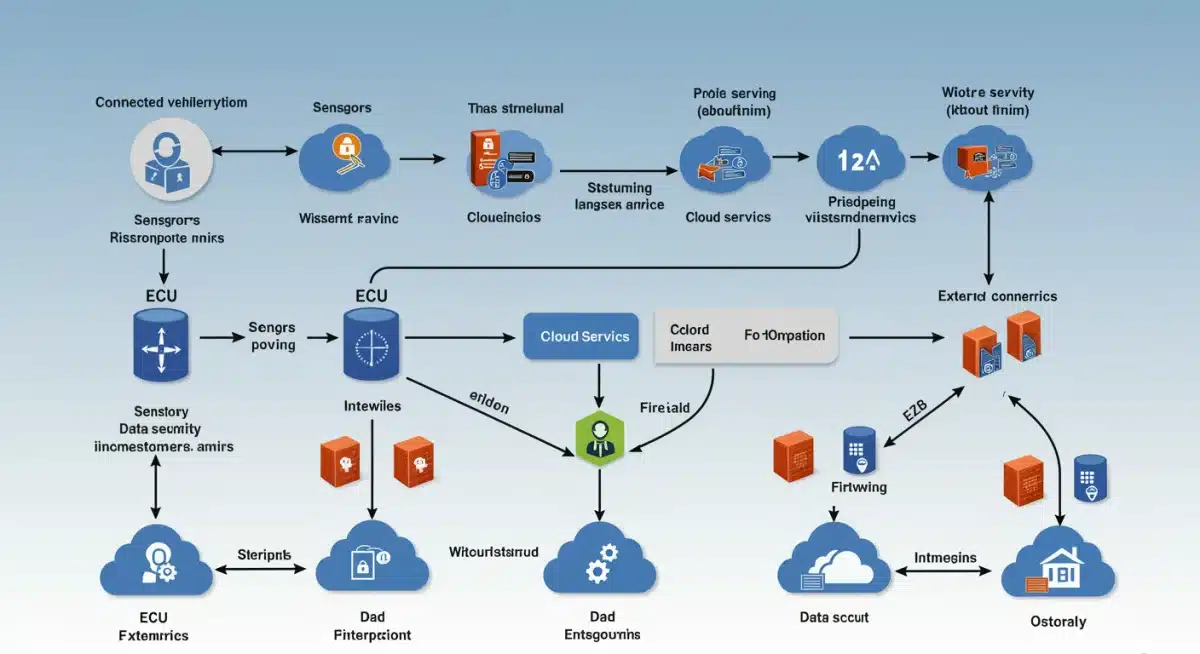
Key Industry Collaborations
Several initiatives are driving progress in automotive cybersecurity. These collaborations are vital for standardizing security measures and ensuring interoperability across different vehicle platforms and technologies.
- SAE International Standards: SAE J3061, ‘Cybersecurity Guidebook for Cyber-Physical Vehicle Systems,’ provides a foundational framework for vehicle cybersecurity engineering.
- Joint Research & Development: Automakers are pooling resources for R&D into advanced cryptographic techniques, intrusion detection systems, and secure software development.
- Supply Chain Security: Emphasis is placed on securing the entire supply chain, from component manufacturers to software developers, ensuring that vulnerabilities are addressed at every stage.
These efforts underscore a collective understanding that a chain is only as strong as its weakest link, making comprehensive security across the entire automotive ecosystem paramount for Cybersecurity for Connected Vehicles: Protecting US Automotive Data in 2025 and Beyond.
The Role of Advanced Technologies in Automotive Security
Advanced technologies are not only enabling connected vehicle features but also providing powerful tools for enhancing their security. Artificial intelligence (AI), machine learning (ML), and blockchain are being explored and implemented to create more robust and adaptive cybersecurity defenses.
AI and ML can be particularly effective in detecting anomalies and identifying potential cyberattacks in real time. By analyzing vast amounts of data from vehicle systems, these technologies can learn normal operational patterns and flag deviations that might indicate a compromise.
Innovations in Cybersecurity Defenses
The integration of cutting-edge technologies offers promising avenues for proactive and reactive cybersecurity measures. These innovations are crucial for staying ahead of sophisticated cyber threats.
- Intrusion Detection and Prevention Systems (IDPS): AI-powered IDPS can monitor vehicle networks for suspicious activity and automatically block threats.
- Secure Boot and Firmware Over-the-Air (FOTA): Ensuring that only authenticated and verified software can run on vehicle systems and that updates are delivered securely.
- Blockchain for Data Integrity: Distributed ledger technology can provide immutable records of data transactions, enhancing the integrity and trustworthiness of vehicle data.
These technological advancements are transforming how automotive cybersecurity is approached, shifting from reactive patching to proactive and intelligent defense mechanisms. The continuous development and deployment of such tools are vital for safeguarding connected vehicles against future threats.
Protecting Consumer Privacy and Data Governance
Beyond vehicle safety, the vast amounts of data collected by connected cars raise significant privacy concerns. From driving habits and location data to biometric information, vehicles are becoming rich sources of personal data that must be protected with stringent governance policies.
Consumers are increasingly aware of their data rights, and manufacturers face growing pressure to be transparent about what data is collected, how it is used, and how it is secured. Effective data governance is therefore a critical component of automotive cybersecurity strategies.
Challenges in Data Privacy and Consent
Managing data privacy in connected vehicles involves navigating complex legal and ethical considerations. Obtaining informed consent and ensuring data anonymization are ongoing challenges for the industry.
- Data Minimization: Collecting only the necessary data to perform a function, reducing the risk exposure.
- Transparent Consent Mechanisms: Clearly informing users about data collection practices and providing easy-to-understand consent options.
- Anonymization and Pseudonymization: Implementing techniques to protect individual identities while still allowing for data analysis and service improvements.
The industry is working towards harmonizing data privacy practices with existing regulations like the California Consumer Privacy Act (CCPA) and aiming for global best practices. Strong data governance frameworks are essential for building and maintaining consumer trust in connected vehicle technologies.
Future Outlook: 2025 and Beyond
As we look towards 2025 and the years beyond, the landscape of Cybersecurity for Connected Vehicles: Protecting US Automotive Data in 2025 and Beyond will continue to evolve rapidly. The increasing sophistication of both vehicle technology and cyber threats demands a forward-thinking and adaptive approach to security.
The convergence of autonomous driving, vehicle-to-everything (V2X) communication, and electric vehicle technologies will introduce new complexities and potential vulnerabilities. Proactive research, continuous innovation, and strong regulatory oversight will be critical to navigate these challenges successfully.
Emerging Trends and Challenges
The future of connected vehicle cybersecurity will be shaped by several key trends, each presenting both opportunities and challenges for security professionals and policymakers.
- Quantum Computing Threats: The advent of quantum computing could potentially break current encryption standards, necessitating the development of post-quantum cryptography.
- Software-Defined Vehicles (SDVs): While offering flexibility, SDVs also increase the reliance on software, making secure software development lifecycles even more important.
- Global Harmonization of Standards: As connected vehicles operate across borders, there’s a growing need for internationally harmonized cybersecurity standards and regulations.
The ongoing commitment to security by design, continuous monitoring, and rapid incident response will be paramount. The goal is to ensure that the benefits of connected vehicle technology are realized without compromising the safety, security, and privacy of users.
| Key Point | Brief Description |
|---|---|
| Evolving Threats | Connected vehicles face increasing cyberattack sophistication, targeting infotainment, telematics, and ECUs. |
| US Regulations | NHTSA and FTC actively develop and enforce guidelines for automotive cybersecurity and data privacy. |
| Industry Collaboration | Automakers and tech firms collaborate through Auto-ISAC and SAE to share threat intelligence and develop standards. |
| Advanced Security Tech | AI, ML, and blockchain are being integrated for real-time threat detection and enhanced data integrity. |
Frequently Asked Questions About Connected Vehicle Cybersecurity
Primary risks include unauthorized access to vehicle systems, data breaches of personal information, remote vehicle control, and manipulation of sensor data critical for autonomous functions. These vulnerabilities can impact safety, privacy, and vehicle integrity.
The US government, primarily through NHTSA, provides guidance and best practices for manufacturers, emphasizing security by design and incident response. The FTC also addresses consumer data privacy concerns related to connected vehicle data collection.
Automakers are implementing security by design, engaging in threat modeling, developing secure software, and collaborating through industry groups like Auto-ISAC to share intelligence and establish common security standards across the ecosystem.
AI and machine learning are used for real-time intrusion detection. Secure boot mechanisms verify software integrity, and blockchain technology can ensure the immutability and trustworthiness of critical vehicle data and transactions.
Consumers should regularly update vehicle software, understand their car’s data privacy settings, use strong passwords for connected services, and be cautious about connecting to unsecured public Wi-Fi networks through their vehicle’s infotainment system.
Looking Ahead: Impact and Implications
The ongoing efforts in Cybersecurity for Connected Vehicles: Protecting US Automotive Data in 2025 and Beyond will profoundly shape the future of transportation. As vehicles become more autonomous and interconnected, the integrity of their systems and the privacy of their data are not merely technical challenges but fundamental pillars of public trust and safety. Upcoming legislative actions and continued industry innovation will be crucial in defining the security posture of the next generation of vehicles. Expect to see increased collaboration between global regulatory bodies to harmonize standards, reflecting the international nature of the automotive industry and cyber threats. The focus will remain on building resilient, secure systems from the ground up, ensuring that the promise of connected mobility is delivered safely and securely to consumers.


